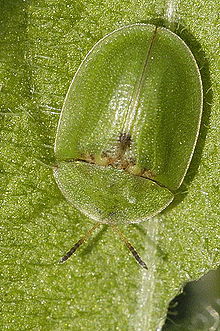| Thistle tortoise beetle | |
|---|---|

| |
| Scientific classification | |
| Domain: | Eukaryota |
| Kingdom: | Animalia |
| Phylum: | Arthropoda |
| Class: | Insecta |
| Order: | Coleoptera |
| Family: | Chrysomelidae |
| Genus: | Cassida |
| Species: | C. rubiginosa
|
| Binomial name | |
| Cassida rubiginosa Müller, 1776 [1]
| |
The thistle tortoise beetle (Cassida rubiginosa) is a species of beetle in the subfamily Cassidinae (tortoise beetles) and the genus Cassida. The thistle tortoise beetle can be recognized by its green, rounded back and it can be found on thistle plants in many regions of North America and Europe. The thistle tortioise beetle was first discovered in 1902 in Lévis, Quebec. In 1931, Nellie F. Paterson was the first to document the mature larva. Later, the instar larva of this species was first recorded in 2004 by Jolanta Świętojańska. The thistle tortoise beetle exhibits multiple defense behaviors, such as a flexible shield, providing a barrier against the mandibles of predators, and an excretion that protects the eggs as well.
Its ability to massively consume and damage thistle plants has also made this beetle a well known biological control agent in many countries, including the United States, Canada, and Switzerland. However, in some cases, the impact of these beetles has been limited due to parasitism preventing their accumulation in regions of thistle targeted for biological control.